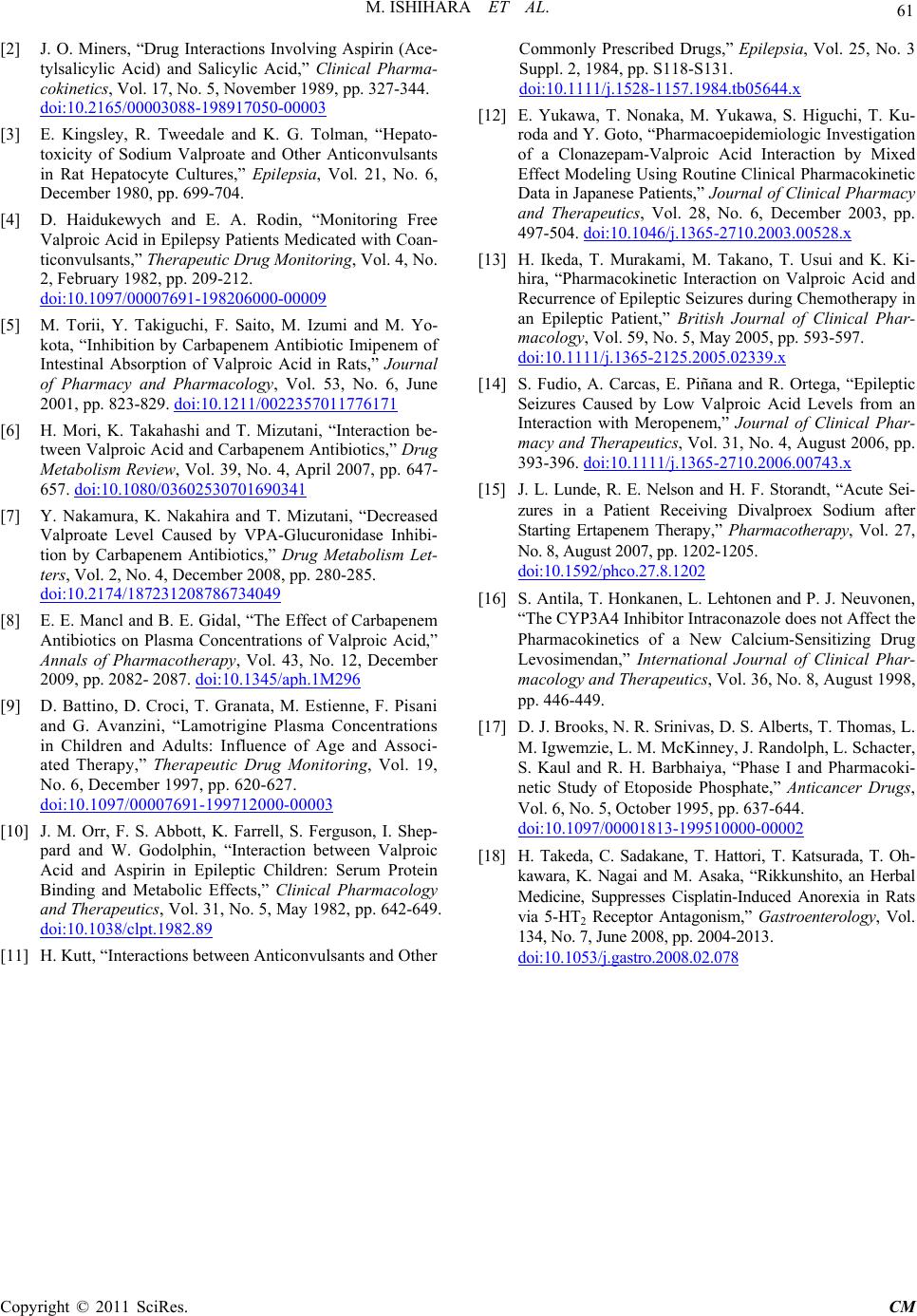
M. ISHIHARA ET AL.
61
[2] J. O. Miners, “Drug Interactions Involving Aspirin (Ace-
tylsalicylic Acid) and Salicylic Acid,” Clinical Pharma-
cokinetics, Vol. 17, No. 5, November 1989, pp. 327-344.
doi:10.2165/00003088-198917050-00003
[3] E. Kingsley, R. Tweedale and K. G. Tolman, “Hepato-
toxicity of Sodium Valproate and Other Anticonvulsants
in Rat Hepatocyte Cultures,” Epilepsia, Vol. 21, No. 6,
December 1980, pp. 699-704.
[4] D. Haidukewych and E. A. Rodin, “Monitoring Free
Valproic Acid in Epilepsy Patients Medicated with Coan-
ticonvulsants,” Therapeutic Drug Monitoring, Vol. 4, No.
2, February 1982, pp. 209-212.
doi:10.1097/00007691-198206000-00009
[5] M. Torii, Y. Takiguchi, F. Saito, M. Izumi and M. Yo-
kota, “Inhibition by Carbapenem Antibiotic Imipenem of
Intestinal Absorption of Valproic Acid in Rats,” Journal
of Pharmacy and Pharmacology, Vol. 53, No. 6, June
2001, pp. 823-829. doi:10.1211/0022357011776171
[6] H. Mori, K. Takahashi and T. Mizutani, “Interaction be-
tween Valproic Acid and Carbapenem Antibiotics,” Drug
Metabolism Review, Vol. 39, No. 4, April 2007, pp. 647-
657. doi:10.1080/03602530701690341
[7] Y. Nakamura, K. Nakahira and T. Mizutani, “Decreased
Valproate Level Caused by VPA-Glucuronidase Inhibi-
tion by Carbapenem Antibiotics,” Drug Metabolism Let-
ters, Vol. 2, No. 4, December 2008, pp. 280-285.
doi:10.2174/187231208786734049
[8] E. E. Mancl and B. E. Gidal, “The Effect of Carbapenem
Antibiotics on Plasma Concentrations of Valproic Acid,”
Annals of Pharmacotherapy, Vol. 43, No. 12, December
2009, pp. 2082- 2087. doi:10.1345/aph.1M296
[9] D. Battino, D. Croci, T. Granata, M. Estienne, F. Pisani
and G. Avanzini, “Lamotrigine Plasma Concentrations
in Children and Adults: Influence of Age and Associ-
ated Therapy,” Therapeutic Drug Monitoring, Vol. 19,
No. 6, December 1997, pp. 620-627.
doi:10.1097/00007691-199712000-00003
[10] J. M. Orr, F. S. Abbott, K. Farrell, S. Ferguson, I. Shep-
pard and W. Godolphin, “Interaction between Valproic
Acid and Aspirin in Epileptic Children: Serum Protein
Binding and Metabolic Effects,” Clinical Pharmacology
and Therapeutics, Vol. 31, No. 5, May 1982, pp. 642-649.
doi:10.1038/clpt.1982.89
[11] H. Kutt, “Interactions between Anticonvulsants and Other
Commonly Prescribed Drugs,” Epilepsia, Vol. 25, No. 3
Suppl. 2, 1984, pp. S118-S131.
doi:10.1111/j.1528-1157.1984.tb05644.x
[12] E. Yukawa, T. Nonaka, M. Yukawa, S. Higuchi, T. Ku-
roda and Y. Goto, “Pharmacoepidemiologic Investigation
of a Clonazepam-Valproic Acid Interaction by Mixed
Effect Modeling Using Routine Clinical Pharmacokinetic
Data in Japanese Patients,” Journal of Clinical Pharmacy
and Therapeutics, Vol. 28, No. 6, December 2003, pp.
497-504. doi:10.1046/j.1365-2710.2003.00528.x
[13] H. Ikeda, T. Murakami, M. Takano, T. Usui and K. Ki-
hira, “Pharmacokinetic Interaction on Valproic Acid and
Recurrence of Epileptic Seizures during Chemotherapy in
an Epileptic Patient,” British Journal of Clinical Phar-
macology, Vol. 59, No. 5, May 2005, pp. 593-597.
doi:10.1111/j.1365-2125.2005.02339.x
[14] S. Fudio, A. Carcas, E. Piñana and R. Ortega, “Epileptic
Seizures Caused by Low Valproic Acid Levels from an
Interaction with Meropenem,” Journal of Clinical Phar-
macy and Therapeutics, Vol. 31, No. 4, August 2006, pp.
393-396. doi:10.1111/j.1365-2710.2006.00743.x
[15] J. L. Lunde, R. E. Nelson and H. F. Storandt, “Acute Sei-
zures in a Patient Receiving Divalproex Sodium after
Starting Ertapenem Therapy,” Pharmacotherapy, Vol. 27,
No. 8, August 2007, pp. 1202-1205.
doi:10.1592/phco.27.8.12 02
[16] S. Antila, T. Honkanen, L. Lehtonen and P. J. Neuvonen,
“The CYP3A4 Inhibitor Intraconazole does not Affect the
Pharmacokinetics of a New Calcium-Sensitizing Drug
Levosimendan,” International Journal of Clinical Phar-
macology and Therapeutics, Vol. 36, No. 8, August 1998,
pp. 446-449.
[17] D. J. Brooks, N. R. Srinivas, D. S. Alberts, T. Thomas, L.
M. Igwemzie, L. M. McKinney, J. Randolph, L. Schacter,
S. Kaul and R. H. Barbhaiya, “Phase I and Pharmacoki-
netic Study of Etoposide Phosphate,” Anticancer Drugs,
Vol. 6, No. 5, October 1995, pp. 637-644.
doi:10.1097/00001813-199510000-00002
[18] H. Takeda, C. Sadakane, T. Hattori, T. Katsurada, T. Oh-
kawara, K. Nagai and M. Asaka, “Rikkunshito, an Herbal
Medicine, Suppresses Cisplatin-Induced Anorexia in Rats
via 5-HT2 Receptor Antagonism,” Ga str oe nterology, Vol.
134, No. 7, June 2008, pp. 2004-2013.
doi:10.1053/j.gastro.2008.02.078
Copyright © 2011 SciRes. CM